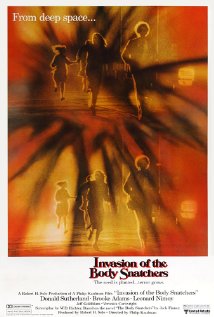Shortly after Elizabeth Driscoll (Brooke Adams) discovers a strange plant in her San Francisco-area yard that she cannot identify, her boyfriend begins acting strangely–he looks the same, but Elizabeth swears he’s a different person. Before long, more and more people are claiming the same thing about their friends and relatives. Just what is going on? Although not quite as good as the original Invasion of the Body Snatchers (1956), this remake is very interesting and well worth a watch. Some things it does better than the original, although slightly more is not done as well. But it is full or intriguing ideas, some beautiful cinematography, and quite a few quirky charms.
One oddity about this film is that it seems to assume that very few people will watch who aren’t already familiar with the original. Scripter W.D. Richter and director Philip Kaufman give away the “twist” immediately, and there are a number of statements from characters in this film (such as the first time we hear the advice to not fall asleep) that only make sense if one already knows from Don Siegel’s original just why they shouldn’t fall asleep. For this reason, I strongly recommend that anyone interested in this film who hasn’t seen it yet should make sure they watch the original first.
The opening shots, which firmly set this remake into sci-fi territory, are a great idea, even if the execution is somewhat questionable. I’m not sure that Kaufman’s “art gel” works, and the way it moves through space, as if blown by trade winds, is slightly hokey. But I’m willing to forgive a misstep if it’s in service of a great idea, and especially if the misstep is the result of budgetary limitations.
Early in the film, the major asset is the cinematography. There is an excellent, slow tracking shot down a hallway, where we only see our main character by way of her feet and a slight reflection in a window. There are a lot of great “tilted” shots. There are a lot of subtle lighting effects to set mood, and a just as many subtle instances of symbolism for the horrors to come.
The cast, featuring Adams, Donald Sutherland, Jeff Goldblum, Leonard Nimoy and Veronica Cartwright, is an interesting combination of stars who tend to give idiosyncratic performances. Kaufman exploits the collection of personalities well, although occasionally gives us odd “everyone talk at once” scenes which can verge on the brink of annoying. Although I’m not usually the biggest fan of Goldblum (in some roles, such as The Fly, I like him, in some roles he tends to irritate me), I noted an odd similarity between him in this film and an actor and performance I’m much more fond of–David Duchovny and his X-Files character Fox Mulder.
Speaking of that, there is a strong X-Files vibe to this film overall. Whereas the original Invasion had thinly veiled subtexts of fear and doubts of “The Other”–whether politically-rooted (the common analysis is that the original Invasion was a subtext for U.S. fears of communism), religiously-rooted (some see it as a parable about cults, or religions in general) or simply about personal identity (in a philosophical sense of “Who am I/are you?” “What makes one oneself?”), Kaufman’s take has stronger subtexts of encroaching mental illness–fear of losing one’s mind and a generalized, “clinical” paranoia.
Given that difference, it’s perhaps odd that there are so many similarities between the two films. The character structure and relationships are largely the same, with some mostly insignificant differences, including slightly different occupations. There are many scenes taken almost verbatim from the original film, often only with differences of setting, but staged the same, with similar scenarios and occasionally identical dialogue. There is even a wonderful moment where Kevin McCarthy, star of the original film, comes running down the street, screaming that we’re all doomed.
A number of quirky moments push the value of Kaufman’s film up a notch. These are sprinkled throughout the film, but some highlights are a Robert Duvall cameo as a priest inexplicably on a swingset next to toddlers, the “mud bath” parlor, a brief spurt of marvelous, Zappa-sounding avant-garde classical as we witness a chase down a staircase, and a greenhouse in a shipping yard, through which Elizabeth eventually strolls naked, casually walking by employees. The “creature” effects may be better here than in the original, but they are not more effective for that.
But overall, this is a great film. Just make sure you don’t miss the superior original.

